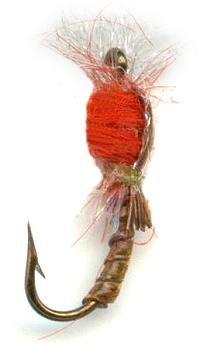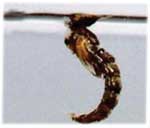Olive Tufted Epoxy Buzzer Midge Nymph
Have you ever turned up at a lake, pool or reservoir to find the trout are feeding on the surface and not looking for subsurface nymphs? The most annoying situation is when you cannot work out what they are feeding on.

BUZZER MIDGE FLY PATTERNS. Hook size 12 14 16 18 20 24 - $US each
Are the fish munching on caddis, damsels, beetles, ants, daddy long legs, olives, emerging adult buzzers or grass hopper? It is high summer. The evening rise has started and because of the large amount for insects on the water you have great difficulty trying to decide what they are going for. What do you do? A trout that is feeding just below the surface can be confused with fish taking food from the surface. Rises can be misleading. A number of times I have been fishing dry flies to match the hatch to find out that the fish were still taking the nymphal stage of the adult insects as it made its way to the surface.
There are times when although the hatch is obvious, clouds of mayflies swarming over the water in the sun, fish feed are finding it more profitable still feasting sub surface most of the time. I hedge my bets by constructing a rig that is designed to fish on the surface and sub-surface at the same time. After 6 inch of a 6lb breaking strain leader I tie an olive klinkhammer, hopper or Goddard’s Caddis hook size 12. This fly covers the emerging insects and the surface stranded terrestrials. I then tie on a brown orange cheeked buzzer hook size 12 on a 2 foot 4lb leader. This length can get varied. This nymph covers the sub surface feeding fish. The third fly is on a 3 foot 3lb fluoroflex leader. This is the surface fly that covers the trout that may be mopping up in the surface film. Either a caddis or mayfly to match the hatch. This seems to cover all bases. If your local water’s rules allow the use of this rig give it a try. You can experiment with different fly patterns. The first fly that is tied on needs to be buoyant enough to support the other two flies.

I have noticed important differences when fishing upland and lowland reservoirs in the early part of the season. Those that have been built in the foot hills of mountains and stocked with rainbow trout are normally saturated with natural food like midge buzzers. I have taken stockfish that have been full to the gills with midge buzzers within days of stocking. This availability of natural food makes important differences to the fly fisherman. From the first day of the season, fly fishing with teams of three midge buzzer imitation fly patterns is very productive.
This contrasts with reduced amount of buzzers available in reservoirs built high up in the mountains because of the colder water temperatures. In these high altitude locations fishing with midge epoxy buzzer imitative patterns does not play such an important part of early season fly fishing for stockfish like rainbows. The buzzers tend to be small and therefore do not provide enough of a distraction to get these fish to switch to natural food as fast as those introduced to lowland reservoirs.


